In addition to the national emblem and anthem, the flag of Portugal is among the widely known symbols of the country’s statehood in the Iberian Peninsula. This deep-rooted element of the citizens’ identity has changed over the years, and is now an amalgamation of at least several currents, traditions, or national reflections on history.
What does the flag of Portugal look like?
The flag of Portugal, or Bandeira de Portugal in the vernacular of the locals, is a rectangular piece of two-color cloth with a field divided into green near the fragment of the spar and red peripherally in a ratio of 2:3. At the place where the aforementioned colors merge, the creators placed the coat of arms on a background of a golden armillary sphere.
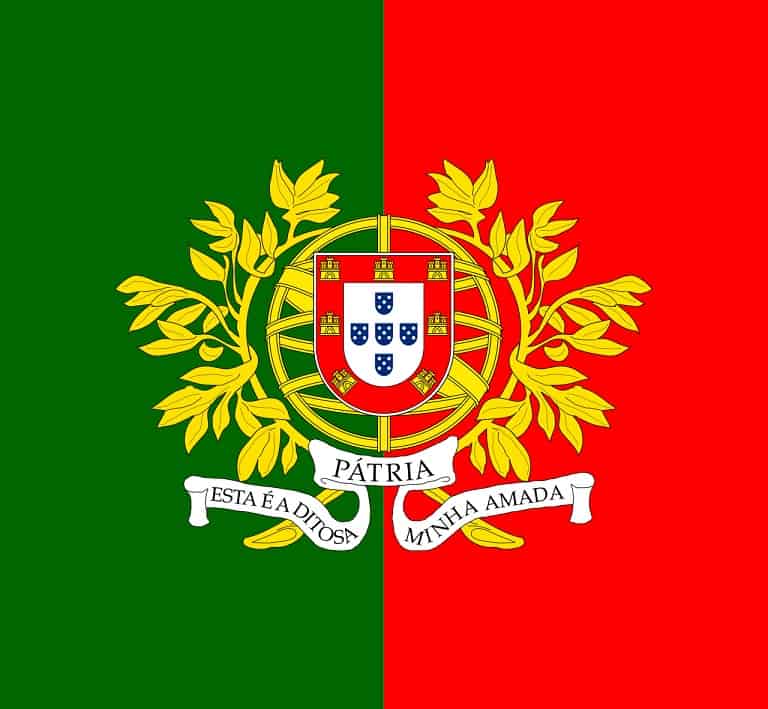
Sometimes the flag of the Portuguese armed forces, also used as a “war banner,” also appears in public spaces. It consists of a square sheet with the country’s coat of arms in the middle, accompanied by a ribbon or unrolled parchment scroll with a quote from Luís Vaz de Camões’ national epic Os Lusiadas, “Esta é a ditosa pátria minha amada,” which translated into English means “Here is my beloved, blissful homeland.”
Symbolism
Like any national symbol, the flag of Portugal carries a huge portion of mystery and mysticism. Their exploration is handled by specialists in heraldry, which studies the relationship between the various elements of coats of arms and flags. As for the symbols and other fragments of the subject under discussion, there are at least several, interesting interpretations of their meaning, especially those that were added to the decor hundreds of years ago during the formative phase of the statehood system. All of these issues make the item a uniquely beautiful reflection of the rich history of thalassocracy. For anyone who wants to learn more about Portugal, the best thing to do is to closely follow the evolution of changes in its design. These metamorphoses are like a diary of concepts in the nation of a particular historical period.
Colors
The final justification for the idea of placing two colors, namely green and red, on the background of the fabric came about during the Estado Novo period. This designation for the state was introduced by the nationalist, authoritarian regime of Antonio Salazar, which held power from 1933 to 1974 after the introduction of a revolutionary constitution. Ideological guides at the time stated that the first color represented the hope of the Portuguese people, while the second symbolized the shed blood of those who died serving the nation.
Armillary Sphere
The yellow ribbon-like structure around the dials represents a navigational instrument known in both civilian and naval navies as an armillary sphere. Portuguese navigators used this tool in conjunction with their knowledge of astrology to help navigate the unknown ocean waters. This symbol is considered by modern heraldists to be a reminder of and tribute to past times of colonial power. It represents the nation’s strength during the so-called Age of Discovery, when brave sailors led by Vasco da Gama and Bartolomeu Dias forged new trade routes during a crucial period in Portuguese history.
Five blue dials
There are many stories about what purpose the patriots had in placing the five, small blue shields on the design of the national flag. One popular theory is that Afonso Henriques carried the same blue cross on his shield into battle during the memorable Reconquista, and the consequent liberation of the Iberian territories from the rule of the invading Moors. The pennant of the time was shaped with five elements, each consisting of a blue background and eleven coins, or Byzantine bezants, arranged in rows. The modern version may loosely refer to this tale.
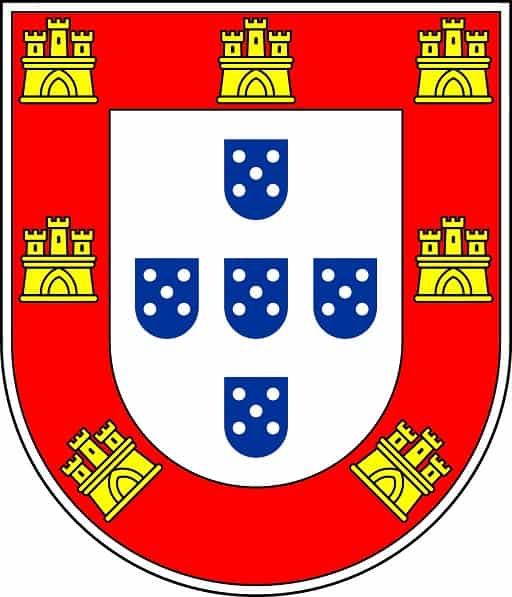
Other historians believe it represented the heads of the metal pins used to attach decorative elements in the Middle Ages, or the seven Muslim leaders killed during the war in Seville, Badajoz, Elvas, Évora, or Beja. The Catholic Church believes that the five dots correspond to the wounds of Jesus Christ on the cross.
Red frame
Seven castles were placed on the red frame. This likely pays homage to Portuguese victories over their Moorish enemies under Afonso III, who allegedly captured seven enemy fortresses during the conquest of the Algarve, completed in 1249. The numerous changes in the number of elements on the periphery of the coat of arms testifies to the lack of consensus on this theory, which directly alludes to the king’s familial ties to Castile, whose family flags consisted of a golden fort on a red field.
History of the Portuguese Flag
The history of the Portuguese flag dates back almost a millennium. During this time it has undergone various modifications, the features, decorative elements of which we can still observe today on the still constitutionally valid model from June 30, 1911.
1095–1248
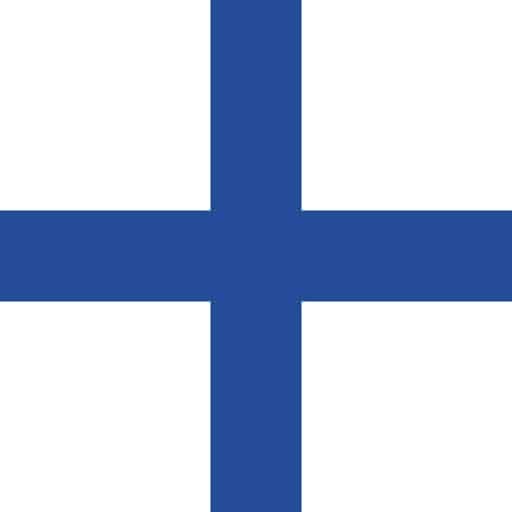
The first heraldic design was proposed by Henry of Burgundy. Several decades later, in the time of Afonso I, it was typical not to repair battle damage inflicted on the shield, so changes such as broken off pieces, loss of color or stains were very common. When Sancho I succeeded his father to the throne in 1185, he inherited a badly damaged pennant. The pattern of the blue cross had disappeared, and only fragments in place of the nails remained. Thus was born the design of five shields placed on the plan of a cross with dots inside.

1248–1495
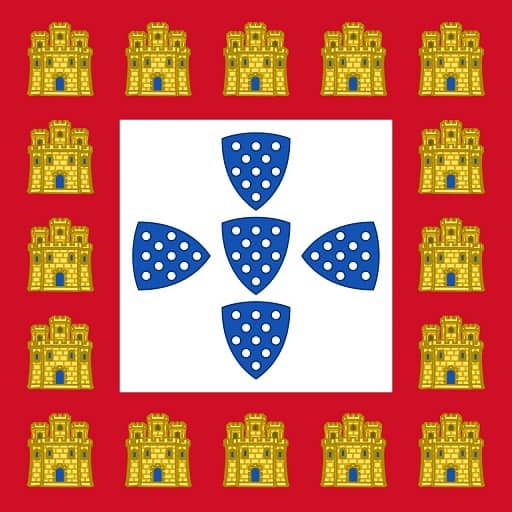
King Afonso III added castles and red outlines in 1248, which can be seen on the flag today. The number of elements around the periphery of the coat of arms varied, and under Sancho II there were as many as sixteen. This was due to ethical reasons regarding the issue of primogeniture, or illegitimate royal descendants.

1495–1667

The number of locks on the red frame was standardized to seven pieces. In addition, King João II, called Excellent by the citizens, replaced the eleven bezants in each shield with five. The total of five shields and 25 coins represents the number of treacherous coins Judas received for surrendering Jesus Christ. However, the most important change is considered to be the change from the original square shape to a shield form, set on a crown in a white rectangular flag.
1667–1830
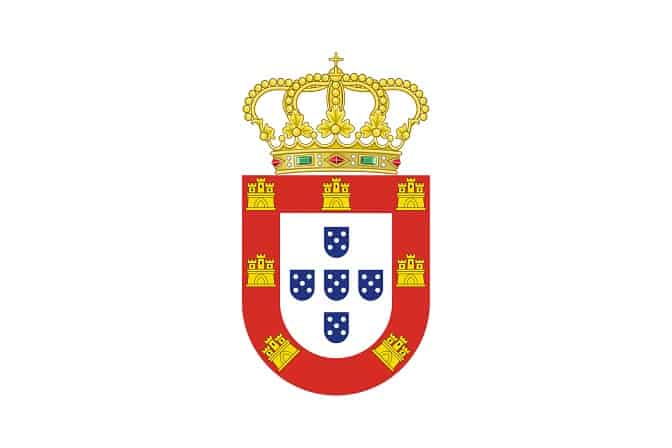
At the time, the flag of Portugal was more or less the same. Each reigning ruler of the country slightly changed the shape of the leading coat of arms as he took the reign, but overall the concept of a shield with a crown mounted on top remained essentially the same.

1830–1910

The government has issued two decrees making modifications to the national flag. While supporters of then usurper King Miguel I continued to uphold the flag’s design from decades ago, liberal volunteers imposed important changes on the flag. The background was evenly divided throughout into blue and white. The armillary sphere was removed, and the coat of arms was centered on the color border. This new configuration was declared for terrestrial use only, but a variation of it was used as the national flag at important state ceremonies.
